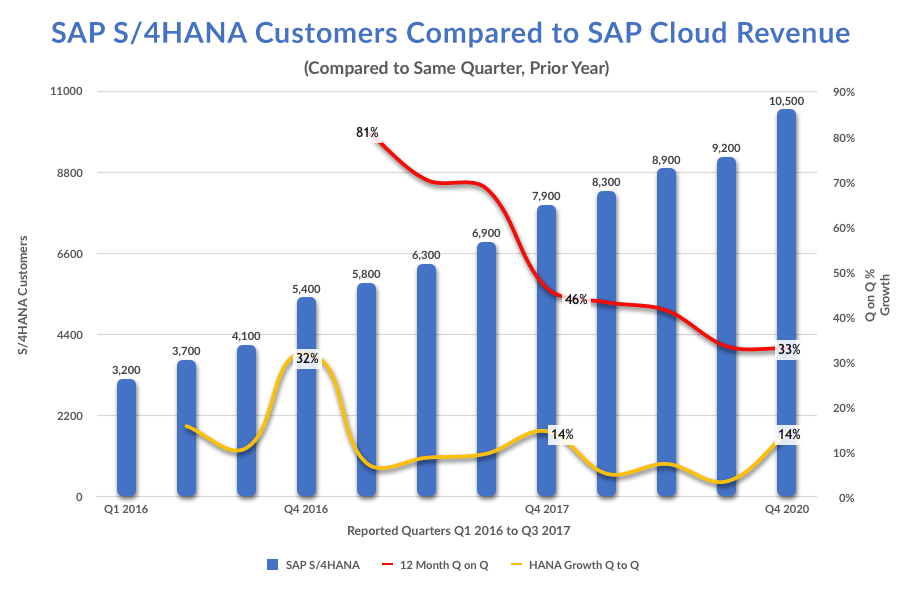- Ted Rogers
- Reading Time: 6 minutes

CEO Bill McDermott said a lot of things during SAP’s Q4 and full year 2018 earnings call on January 29th. But the one thing he did not mention was extending ECC ERP support past 2025. McDermott and CFO Luka Mucic mentioned challenges for SAP because of a softer economy and a reduction of approximately 4,000 roles at the company. But you don’t need to haphazardly dive into an S/4HANA project without considering the risk and benefits of migrating from ECC to S/4HANA.
Just because there was no mention of ending ECC support in 2025 does not mean SAP has any plans to change their direction. Consider these points:
- SAP presented aggressive financial targets that are heavily tied to customers moving to its new products and services
- SAP stated that on-premise software license revenues continue to be a priority
- Some companies have decided to kick the SAP 2025 ECC support ‘can’ for another year, or treat the whole subject as #FakeNews
- You cannot ignore the fact that SAP will someday end ECC support.
Leading Your Enterprise to Address SAP’s ECC End of Support in 2025
The first part of any decision-making process is understanding the problem to solve, or the decision at hand. Chances are, your SAP ECC support or S/4HANA problem statement will resemble one of these:
- My enterprise will need SAP ECC system support past 2025.
- ECC system maintenance cost is an issue for my budget/enterprise, and the enterprise environment mantra is “reduce and cut” rather than “invest and grow.”
- My current ECC environment is prohibitive and challenging to support business agility and effective performance, which could be addressed by migrating to S/4HANA.
Expect to eventually get fired if you plan to migrate to S/4HANA when your problem statement is one of the first two statements. Statement one is a support gap issue, and statement two is a cost issue. Both statements are void of quality, value, and growth enablement. There is nothing innovative or transformational in these first two problem statements — they are entirely inwardly directed toward IT. Attempting to solve these problems with S/4HANA is an expensive solution, not the right answer, and will probably get you fired.
One of the first two problem statements, however, may be your actual situation. If this is the case, then now is not the time to migrate to S/4HANA. But it may be the opportune time to consider a third-party ECC system support solution (e.g., Rimini Street or Spinnaker Support) for your legacy environment.
The ideal S/4HANA problem should resemble the third statement, which is forward looking. This says you are ready to address enterprise-scale deficits in the ability to create quality, value, and growth enablement for your company. Approach statement three with caution: Choosing S/4HANA can still get you fired if you think implementing it is as simple as writing a good problem statement.
Start with What You Know
McDermott stated, “Remember your X’s and O’s, where you have been and where you are going.” Remembering your “X’s” and “O’s” may be good advice from McDermott when thinking about migrating to SAP S/4HANA. A good way to set yourself on a path for failure (and get fired) is neglecting to consider everything in your legacy environment, your “X” – or where you have been.
Do not dismiss the value of what you already know. For example, monetizing and understanding the HOW and WHY your legacy environment evolved to its current configuration is critical, and a big part of your business case. The first step in considering migrating to S/4HANA is to catalog and measure your legacy environment. This is just a sample of data you need to collect and analyze:
- What is your total IT OpEx and CapEx budget allocation to run, break/fix, and grow?
- Does your legacy system diagram resemble a Google Map of Waldorf (are there too many roads/lines in and out of SAP and are most of them red)?
- What does your incident management data tell you? Does it demonstrate “stability” and “reliability”?
- How does the technical debt of your environment negatively impact the sentiment of key enterprise functional stakeholders regarding your agility to meet their expectations?
- Is your department a “cost taker” or a “value enabler” or a “contributor”?
Determining what proportion of your analysis findings are directly and indirectly tied to your SAP ECC/ERP environment will help you frame your S/4HANA strategy planning. Without this data you will have difficulty demonstrating your need to dedicate resources to seriously start considering an S/4HANA project, which…could get you fired.
Choosing to go to S/4HANA
If you choose to go to S/4HANA, the next decision is WHEN. The “when” will be different for every enterprise as the decision will be a balance of both internal and external forces. Internally, the answer comes in your business case.
Shawn Stamp, UpperEdge Project Advisory Services Practice Director, makes the case for a comprehensive business case when he says,
“A comprehensive, solid business case makes that determination up front and becomes the yardstick to help you differentiate between “nice to haves” and “must haves” over the course of your project.”
A perfect business case is not needed at the beginning of your S/4HANA journey, but a good business case is a result of fact-based analysis, enterprise leadership collaboration and involvement, and nothing less than hard work. Your initial framework needs to look at functional and technology codependency that enable shared objectives and goals.
What SAP’s Financial Statements Can Tell Me About Product Maturity, Future Resource Availability or Readiness – And What They do not Say
SAP’s Q4 and full year 2018 preliminary results revealed there are now 10,500 S/4HANA customers, a 14% increase from Q3 2018. As a side bar, this is the same growth rate for Q4 2017, and less than the 32% growth rate observed during Q4 2016. S/4HANA sales from a quarter-to-quarter and annual rate may be flatter and at a lower rate, but customers are still buying S/4HANA.
The number that no one really knows is how many customers have completed their S/4HANA migration programs, and how many customers are in projects with achievable go-live dates. Therefore, potential or new S/4HANA clients should consider a growing inventory of projects underway or yet to begin, and the potential negative impact this would have on available qualified SI resources.
There are no hard numbers to forecast, but we know from studying the transcript from the SAP earnings call for Q3 2018 there are:
- 9,200 S/4HANA customers as of October 2018
- 5,000 customers were either live or in projects with go-live dates
- 2,100 customers were live on S/4HANA
Looking forward, there are 10,500 SAP S/4HANA customers at the close of 2018, but project completion rates may have not grown at the same rate as sales in Q4 and here is why:
- 45% of the S/4HANA customers at the close of Q3 2018 did not have a project with a credible go-live date
- While 32% of S/4 clients have a go-live date, our research shows project failure rates go as high as 70%
- Over 50% of projects exceed budgets
- Few projects achieve a majority of their excepted benefits in the original business case.
Why does this matter?
There are many things to consider for the prospective S/4HANA customer who is trying to determine their current migration path. Aside from product maturity and capability and when to start, there is the availability of credible system integrator resources to assist a sizable enterprise transformation project. Your bigger SI concern should be the quality and prior experience of SI resources. In any labor market, when product demand exceeds capacity, there is usually a huge influx of new labor resources. Expect the same product and labor stress in the SAP S/4HANA SI market.
These points should be used to raise concerns with SIs for all project risks, program failure rates, and missed program benefits. We have seen these points omitted when SIs are approaching new clients during the sales cycle. The willingness and openness of SIs to discuss your concerns and mitigation strategies should be an indication of who you want to listen to and who to dismiss.
Make a Decision on S/4HANA
Your first decision is to make a decision, and not making a decision is a decision. Kicking the SAP S/4HANA can down the road is not advisable given that 2025 is at your doorstep.
You make decisions every day as an enterprise technology leader, or as a senior trusted leader or advisor in your enterprise. The magnitude of the S/4HANA decision is not a decision you and your enterprise make every day. Although this may be the second time your enterprise has made this decision, for most people it is a decision faced maybe once or twice during your career.
Remember:
- Success or failure could be quickly determined just by how you approach the S/4HANA decision. Will you view this decision as solving your SAP ECC 2025 support problem, or enabling and possibly transforming the enterprise?
- What internal and external data will you collect and analyze to start considering third-party ECC system support providers or begin discussions with potential system integrators?
- Who will you seek as counsel, both internally and externally, as you work your way through these early decisions?
You have tough choices to make during the S/4HANA journey. The first decisions are critical to the enterprise, and to your career.
Comment below, follow me, Ted Rogers, on Twitter @UpperEdgeTed find my other UpperEdge blogs and follow UpperEdge on Twitter and LinkedIn.
Related Posts
- How SAP Leverages Mergers and Acquisitions to Force Adoption of S/4HANA
- SAP’s S/4HANA Migration Incentives – Carrots Now and Sticks Later?
- Is Your SAP S/4HANA Transformation Strategy Holistic or Full of Holes?
- Implementing SAP S/4HANA Digital Core – Don’t Be a Prisoner to Unnecessary Costs
- Timing Your Move to S/4HANA

